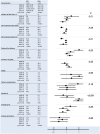Time trends in management of HIV-positive pregnant women in Northern Tanzania: A registry-based study
- PMID: 28957345
- PMCID: PMC5619723
- DOI: 10.1371/journal.pone.0184362
Time trends in management of HIV-positive pregnant women in Northern Tanzania: A registry-based study
Erratum in
-
Correction: Time trends in management of HIV-positive pregnant women in Northern Tanzania: A registry-based study.PLoS One. 2018 Dec 18;13(12):e0209545. doi: 10.1371/journal.pone.0209545. eCollection 2018. PLoS One. 2018. PMID: 30562398 Free PMC article.
Abstract
Objective: To examine time trends in antenatal factors and delivery characteristics in Northern Tanzania, and relate these to national guidelines for HIV in pregnancy.
Design: Registry-based study.
Setting: Northern Tanzania, 2000-2014.
Population or sample: Deliveries (n = 33 346).
Methods: HIV-positive women were compared with HIV-negative women during four periods spanning changing national guidelines.
Main outcome measures: Known maternal HIV status, HIV treatment for woman, number of antenatal care (ANC) visits, routine folate/iron in pregnancy, anemia, delivery complications/interventions.
Results: We observed an increase in deliveries with known maternal HIV status and women receiving HIV treatment, and a decline in deliveries with positive maternal HIV status (p-values for trend <0.001). The proportion of women with less than four ANC visits increased to above 30 percent irrespective of HIV status. Use of routine folate/iron increased, corresponding to a decrease in anemia which was strongest in HIV-negative women. Incidence of elective caesarean section (CS) and emergency CS remained unchanged for HIV-positive women (7.1% and 25.5%, respectively, in the last period). Use of invasive procedures declined in both groups of women. Mothers who were young, single, had low education, high parity or lived in the rural area more often had indicators of poor antenatal care.
Conclusions: Increasing adherence to national guidelines over time was found for most selected outcomes. Still, a high occurrence of insufficient ANC, anemia and emergency CS call for efforts to explore and identify barriers that hinder optimal care.
Conflict of interest statement
Figures


Similar articles
-
Prevalence of HIV and syphilis infections among pregnant women attending antenatal clinics in Tanzania, 2011.BMC Public Health. 2015 May 22;15:501. doi: 10.1186/s12889-015-1848-5. BMC Public Health. 2015. PMID: 25994129 Free PMC article.
-
Alcohol consumption among pregnant women in Northern Tanzania 2000-2010: a registry-based study.BMC Pregnancy Childbirth. 2015 Sep 3;15:205. doi: 10.1186/s12884-015-0630-0. BMC Pregnancy Childbirth. 2015. PMID: 26337194 Free PMC article.
-
The challenge of referring HIV-positive pregnant women with treatment indication from PMTCT to ART services: a retrospective follow-up study in Mbeya, Tanzania.AIDS Care. 2014;26(7):850-6. doi: 10.1080/09540121.2013.869535. Epub 2013 Dec 20. AIDS Care. 2014. PMID: 24359539
-
Boosting antenatal care attendance and number of hospital deliveries among pregnant women in rural communities: a community initiative in Ghana based on mobile phones applications and portable ultrasound scans.BMC Pregnancy Childbirth. 2016 Jun 14;16(1):141. doi: 10.1186/s12884-016-0888-x. BMC Pregnancy Childbirth. 2016. PMID: 27301244 Free PMC article.
-
Frequency, risk factors and feto-maternal outcomes of abruptio placentae in Northern Tanzania: a registry-based retrospective cohort study.BMC Pregnancy Childbirth. 2015 Oct 7;15:242. doi: 10.1186/s12884-015-0678-x. BMC Pregnancy Childbirth. 2015. PMID: 26446879 Free PMC article.
Cited by
-
Correction: Time trends in management of HIV-positive pregnant women in Northern Tanzania: A registry-based study.PLoS One. 2018 Dec 18;13(12):e0209545. doi: 10.1371/journal.pone.0209545. eCollection 2018. PLoS One. 2018. PMID: 30562398 Free PMC article.
-
Adherence to Exclusive Breastfeeding and Associated Factors in Mothers of HIV-Exposed Infants Receiving Care at Kilimanjaro Christian Medical Centre, Tanzania.East Afr Health Res J. 2018;2(1):33-42. doi: 10.24248/EAHRJ-D-16-00365. Epub 2018 Apr 1. East Afr Health Res J. 2018. PMID: 34308173 Free PMC article.
-
Increased perinatal survival and improved ventilation skills over a five-year period: An observational study.PLoS One. 2020 Oct 12;15(10):e0240520. doi: 10.1371/journal.pone.0240520. eCollection 2020. PLoS One. 2020. PMID: 33045029 Free PMC article.
-
Time trends in perinatal outcomes among HIV-positive pregnant women in Northern Tanzania: A registry-based study.PLoS One. 2023 Aug 10;18(8):e0289740. doi: 10.1371/journal.pone.0289740. eCollection 2023. PLoS One. 2023. PMID: 37561712 Free PMC article.
References
-
- Fact Sheet 2016 [Internet]. Joint United Nations Programme on HIV/AIDS (UNAIDS); 2016 [cited 2016 12 June]. http://www.unaids.org/sites/default/files/media_asset/20150901_FactSheet....
-
- Tanzania Commission for AIDS (TACAIDS) ZACZ, National Bureau of Statistics (NBS), Office of the Chief Government Statistician (OCGS), ICF International. Tanzania HIV/AIDS and Malaria Indicator Survey 2011–12: Key Findings [Internet]. Dar es Salaam, Tanzania2013 [cited 2016 12 June]. http://www.dhsprogram.com/pubs/pdf/SR196/SR196.pdf.
-
- The Gap Report 2014 [Internet]. 2014 [updated Sept 2014; cited 2016 June 12]. http://www.unaids.org/sites/default/files/media_asset/UNAIDS_Gap_report_....
-
- Maternal mortality ratio (modeled estimate, per 100,000 live births) [Internet]. The World Bank. [cited June 08 2017]. http://data.worldbank.org/indicator/SH.STA.MMRT?name_desc=false.
-
- Tanzania National Guidelines for the Management of HIV and AIDS [Internet]. Tanzania Ministry of Health and Social Welfare; 2012 [cited 2016 12 June]. 4th:[http://pmtct.or.tz/wp-content/uploads/2013/03/ART-guidelines_PDF.pdf.
MeSH terms
LinkOut - more resources
Full Text Sources
Other Literature Sources
Miscellaneous

